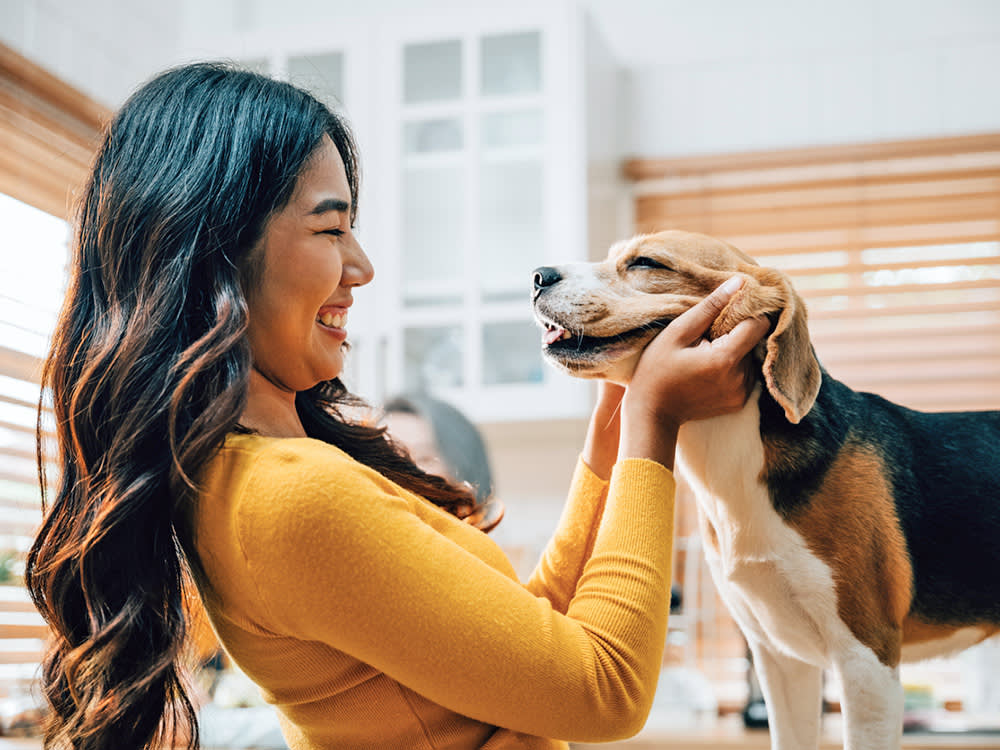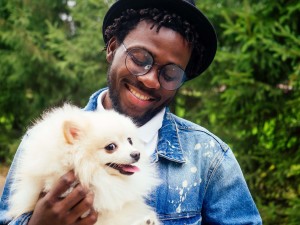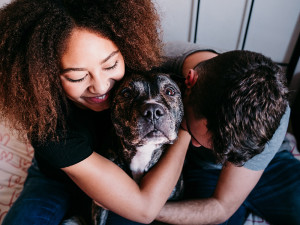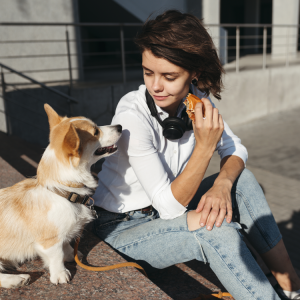Dog and Human Brains Sync When They Stare Into Each Other’s Eyes, New Study Finds
You and your pup are on the same wavelength—seriously.

Share Article
We know what happens in our own brains when we gaze into a dog’s eyes — in non-scientific terms, it’s heaven on earth. Now, thanks to new research, we know that the relationship isn’t one-sided — and those ooey-gooey feelings of connection aren’t made up. A new studyopens in new tab published in Advanced Science found that when dogs and humans stare into each other’s eyes, our brain activity actually syncs up.
Previous research has found that being “on the same wavelength” is a real thing; while socializing or working on an activity together, our neural activity can sync up with other peoples’opens in new tab — in fact, when we’re really enjoying a concert, our brain activity becomes similaropens in new tab to that of the musician’s. Similar syncing has been found in mice,opens in new tab bats,opens in new tab and monkeysopens in new tab, and it has been shown to increase attention and the quality of social interactions.opens in new tab The latest research proves that this harmony doesn’t just happen between creatures of the same species; humans’ brains match up with our dogs, too.
The study
In the study, ten Beagles were paired with ten unknown humans. The humans and Beagles both had electroencephalograms (EEGs) measuring their brain activity as they engaged in petting and mutual gazing.
“We observed that interbrain correlations in frontal and parietal regions dramatically increased … during mutual gaze,” wrote Wei Ren, the study’s lead author. The brain activity was even more synced when humans both pet and gazed at the dogs.

The more familiar with each other they were, the greater the connection. “The strength of the synchronization increases with growing familiarity of the human–dog dyad over five days,” Ren wrote.
Previous research has found that petting a dog increases activity in a human’s prefrontal cortex, which can help us improve our social skills, emotional regulation, and attention spans — but this is the first evidence that this increased brain activity is at work in a pup’s brain during bonding, too. So, give your pup a chin scratch and stare into those puppy eyes; it’s bonding, it’s good for both of your brains...and you were going to anyway, right?

Sio Hornbuckle
Sio Hornbuckle is the Assistant Editor at Kinship, where they frequently write for the site. As a writer, they specialize in pet news, animal science, and pop culture. They live in New York City with their cat, Toni Collette.
Related articles
![Man hugging his fluffy white dog happily]()
Chemistry Between People and Dogs Is Real (It’s Science)
How the “love hormone” oxytocin connects us with our pups.
![Valentin Pujadas illustration]()
FYI, Pets Are Incredibly Good For Your Mental Health
Experts share the science-backed ways our pets offer us emotional support.
![Couple hugs their merle Boxer]()
How to Improve Your Relationship with Your Dog
Animal behaviorist Dr. Karen B. London on how to strengthen your pet-parent bond.
![corgi giving woman puppy dog eyes begging for food]()
A New Study Debunks the Theory That “Puppy Dog Eyes” Are for Humans’ Benefit
Apparently wild dogs can be pretty cute, too.
![Young woman looking at cellphone with her dog]()
Does Your Dog Understand When You FaceTime Them?
It’s a nice thought.
![Happy young woman in yoga clothes holding small tan dog in park]()
The Healthiest Thing You Can Do Is Get a Dog, Harvard Report Says
Scientists confirm the myriad physical and psychological benefits of pet parenthood.






